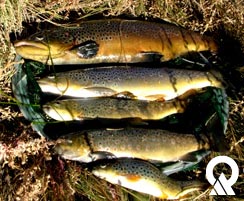By Amy Dickey
Editor’s Note: The recent release of metals-laden sediment from Tibble Fork Reservoir has raised concerns among anglers about heavy-metals contamination in fish in the American Fork River. The Division of Wildlife Resources (DWR) is currently collecting live fish downstream from the reservoir and will be testing them for the presence of metals such as lead and zinc. Amy Dickey’s 2014 blog about mercury in fish provides background information on the ways metals can accumulate in fish tissue and what you can do to protect yourself.

Summertime in Utah means hiking, biking, barbeques, fireworks and … fishing! Warm summer days mean more folks are out fishing at Utah’s blue-ribbon streams, high-alpine lakes, reservoirs and urban ponds. Many anglers eat what they catch, which is a good thing, since fish provides important vitamins, minerals, and Omega-3 fatty acids that people need for a healthy diet.
Unfortunately, when fishing spots become polluted, your catch may also become contaminated with high concentrations of mercury and other harmful chemicals. Fortunately, Utah has a statewide program that monitors mercury levels in fish and issues advisories to let people know when fish at a particular location are unsafe to eat.
Mercury is a naturally occurring element in our air, soil and water. Atmospheric mercury makes its way into water bodies through rain or snow (wet deposition), or the settling of gases and particles from the air (dry deposition). Other sources of mercury include storm water and industrial discharges. Bacteria in the soils and sediments at the bottom of lakes and streams convert naturally occurring mercury into a more toxic form known as methylmercury. Unlike elemental mercury, methylmercury bioaccumulates in organisms, becoming more concentrated in their bodies the more they ingest. Methylmercury also biomagnifies, meaning organisms contain more of the toxin the higher up they are in the food chain.
Mercury acts as a neurotoxin and has the potential to damage the brain, heart, lungs, kidneys and immune system. Pregnant women and nursing mothers are at risk because methylmercury impacts fetal development and passes from mother to child through breast milk. Young children are also at higher risk because their nervous systems are still developing.
Public health officials in Utah issue fish advisories when mercury levels in fish reach unsafe levels. These advisories provide recommendations on how much of a particular type of fish is safe to eat. Anglers can look up this information by county, waterbody, or fish species on the Utah Fish Advisory website.
The Division of Water Quality (DWQ) has teamed with the Division of Wildlife Resources (DWR) and Utah Department of Health (UDOH) to develop collection plans, catch and sample fish, analyze the data, and determine consumption values. Since the Utah program began, more than 4,000 fish have been collected from 300 sites (218 river and 83 lake) throughout the state, with consumption advisories issued at 24 locations for 13 different fish species.
It’s important to keep in mind that just eight percent of the sites sampled warranted consumption advisories. So remember: You can eat fish—just choose wisely. Know the locations of advisories and the species they include. And enjoy yourself at your favorite lake or reservoir—there are no known health risks associated with swimming and boating in waterbodies with mercury advisories.
Going fishing? Check out the state’s fish advisory website for more information on advisory locations, fish species and recommended consumption amounts. EPA’s Mercury website has additional information about fish consumption, health effects and the ways people can be exposed to mercury. The Food and Drug Administration has issued Draft Advice on mercury levels in fish that can help you make informed choices before you purchase fish at a grocery store or restaurant.

I have worked with the Utah Division of Water Quality for 15 years. I have a Bachelor’s degree in Biology and Environmental Studies. When I’m not working, I love to get outside and enjoy all that Utah has to offer. I especially enjoy camping with my husband and two kids.

